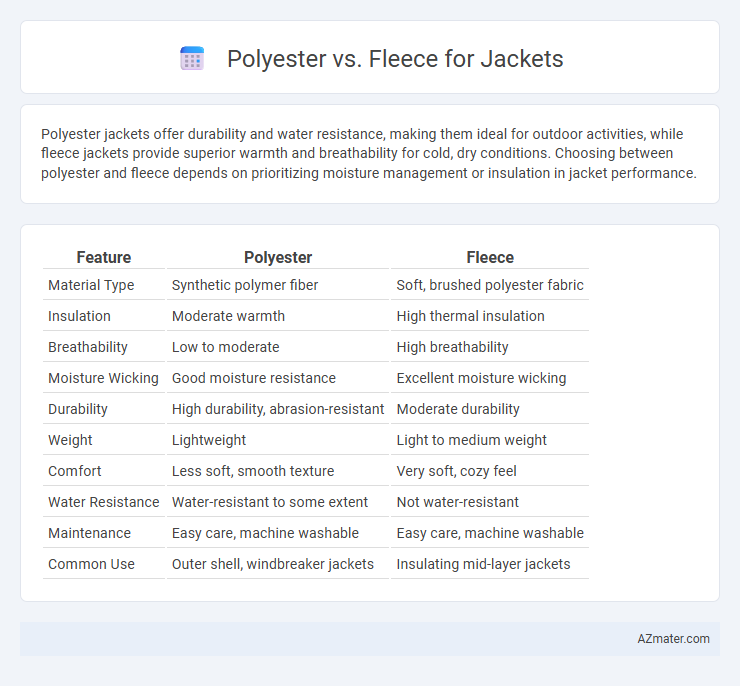Polyester jackets offer durability and water resistance, making them ideal for outdoor activities, while fleece jackets provide superior warmth and breathability for cold, dry conditions. Choosing between polyester and fleece depends on prioritizing moisture management or insulation in jacket performance.
Table of Comparison
| Feature | Polyester | Fleece |
|---|---|---|
| Material Type | Synthetic polymer fiber | Soft, brushed polyester fabric |
| Insulation | Moderate warmth | High thermal insulation |
| Breathability | Low to moderate | High breathability |
| Moisture Wicking | Good moisture resistance | Excellent moisture wicking |
| Durability | High durability, abrasion-resistant | Moderate durability |
| Weight | Lightweight | Light to medium weight |
| Comfort | Less soft, smooth texture | Very soft, cozy feel |
| Water Resistance | Water-resistant to some extent | Not water-resistant |
| Maintenance | Easy care, machine washable | Easy care, machine washable |
| Common Use | Outer shell, windbreaker jackets | Insulating mid-layer jackets |
Introduction to Polyester and Fleece Jackets
Polyester jackets offer lightweight durability and excellent moisture-wicking properties, making them ideal for active outdoor wear. Fleece jackets are made from soft, insulating synthetic fibers that provide warmth and breathability, perfect for layering in cold weather. Both materials deliver versatile performance, but polyester excels in water resistance while fleece prioritizes comfort and thermal insulation.
Material Overview: What is Polyester?
Polyester is a synthetic fiber derived from petroleum-based products, widely used in jacket manufacturing due to its durability, moisture-wicking properties, and resistance to shrinking and stretching. Its fiber structure allows for excellent wrinkle resistance and quick drying, making it ideal for outdoor and activewear jackets. Often blended with other materials, polyester enhances the overall performance and longevity of fleece jackets by providing structural strength and improved insulation.
Material Overview: What is Fleece?
Fleece is a lightweight, synthetic fabric made primarily from polyester fibers, designed to mimic the insulating properties of wool while offering superior breathability and moisture-wicking capabilities. It features a soft, napped surface created through a knitting process that traps air, providing excellent warmth and comfort in jackets. Unlike traditional polyester fabrics, fleece is engineered for enhanced thermal regulation and quick drying, making it ideal for activewear and outdoor clothing.
Warmth and Insulation Comparison
Polyester jackets offer moderate warmth and effective moisture-wicking properties, making them suitable for mild to cool weather conditions. Fleece jackets provide superior insulation and retain heat efficiently due to their dense pile construction, excelling in cold and dry environments. While polyester is lightweight and quick-drying, fleece's breathable nature ensures sustained warmth without overheating during physical activities.
Breathability and Moisture Management
Polyester jackets offer moderate breathability and excel in moisture-wicking properties, effectively pulling sweat away from the skin to keep you dry during active use. Fleece, made from synthetic fibers, provides excellent insulation and warmth but is less breathable, trapping heat and moisture close to the body, which may lead to discomfort during intense activities. For optimal moisture management and breathability, polyester outer shells with fleece linings combine the benefits of both materials, enhancing comfort and performance in varied weather conditions.
Durability and Longevity
Polyester jackets offer exceptional durability due to their resistance to stretching, shrinking, and abrasion, making them ideal for long-term wear. Fleece, while soft and insulating, tends to experience pilling and fabric wear more quickly under frequent use. Choosing polyester ensures better longevity and maintains structural integrity over time compared to fleece.
Comfort and Softness
Polyester jackets provide durability and water resistance but can sometimes feel less breathable and slightly rougher compared to fleece. Fleece, made from synthetic fibers like polyester but with a brushed, plush texture, offers exceptional softness and superior warmth, making it ideal for comfort-focused outerwear. When choosing between the two, fleece excels in softness and coziness, while polyester jackets offer practical weather protection with moderate comfort.
Style and Aesthetic Differences
Polyester jackets often feature a sleek, smooth finish that lends a modern, lightweight appearance suitable for urban and activewear styles. Fleece jackets, made from soft, fluffy synthetic fibers, provide a cozy, textured look that emphasizes casual comfort and outdoor ruggedness. The choice between polyester's polished sheen and fleece's plush warmth significantly impacts the jacket's overall aesthetic and style appeal.
Environmental Impact and Sustainability
Polyester jackets rely on petroleum-based synthetic fibers that contribute to microplastic pollution and have a significant carbon footprint during production. Fleece, often made from recycled polyester, offers a more sustainable alternative by repurposing plastic waste but still generates microplastics when washed. Choosing recycled polyester fleece can reduce environmental impact, although natural fiber alternatives generally provide better biodegradability and lower emissions.
Which is Better: Polyester or Fleece for Jackets?
Polyester jackets offer durability, water resistance, and lightweight warmth, making them ideal for outdoor activities and variable weather conditions. Fleece jackets provide superior breathability, moisture-wicking properties, and exceptional comfort, perfect for layering in cooler, dry environments. Choosing between polyester and fleece depends on your specific needs: polyester suits active, wet conditions, while fleece excels in insulation and softness for casual wear.

Infographic: Polyester vs Fleece for Jacket
 azmater.com
azmater.com